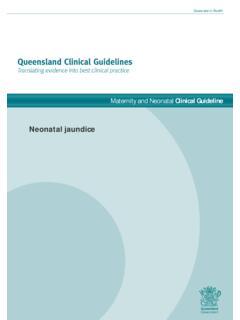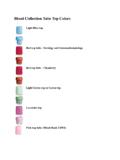Transcription of Wome Guideline - NHS England
1 The Rosie Hospital (Maternity) Women s and children s directorate Cambridge University Hospitals NHS Foundation Trust Page 1 of 16 High Risk Neonatal Jaundice in the newborn Version 7; Approved xxx 2012 Guideline Jaundice in the newborn: screening and assessment Key points Screening & assessment 1. All parents should be offered information about neonatal jaundice that is tailored to their needs. A specific jaundice leaflet should be given to those babies identified as having a risk factor for significant hyperbilirubinaemia (see table 1). 2. With regard to the four risk factors for significant jaundice (table 1, page 3): All midwives should be familiar with these risk factors All babies in these at risk groups should be visually inspected on days one and two of life (ie daily in first 48 hours).
2 Babies who are visibly jaundiced within the first 24 hours (risk factor 3) and who are still in hospital must not be sent home. All other at- risk babies in hospital should be notified to the community midwife and, if discharged before day two, all those with risk factors 1, 2 and 4 should receive an extra post-natal contact by the community midwife/ maternity support worker in the first 48 hours, ie be reviewed on post-natal days one and two. 3. A visual inspection alone is inadequate in assessing the level of jaundice: where there is obvious visible jaundice, the bilirubin level should be monitored by the transcutaneous bilirubinometer device, if available, or by serum measurement. 4. The interpretation of the TCBR should follow the guidance in section 6 and in figures 1 and 2.
3 5. All babies who develop jaundice before 24 hours of age should have an urgent review on the same day (ideally within two hours) by a paediatrician/ neonatologist so that investigation can be initiated and treament given, if required. Babies in the community should be discussed with the on-call paediatric registrar and referred to the paediatric team in the childrens observation unit (see figure 2, page 9). 6. All term babies with jaundice after 14-21 days of birth should be referred to the baby Review clinic by contacting the on-call Neonatal Registrar (see section 6) and a letter of referral faxed through to NICU (see section 6 and figure 2). 7. Babies with jaundice should have a midwifery care plan written, which may include attention to: ensuring the baby is well hydrated by initiating early, regular feeds this may include waking a sleepy baby to feed and stimulating the baby to ensure frequent feeding; observing the baby for signs of lethargy, dehydration and/ or significant weight loss.
4 Treatment 1. Infants, whose serum bilirubin has reached, or exceeded, the threshold level should commence phototherapy. 2. The NICE SBR treatment tables or charts from NICE for the appropriate gestational age should be used for the interpretation of SBR values. The Rosie Hospital (Maternity) Women s and children s directorate Cambridge University Hospitals NHS Foundation Trust Page 2 of 16 High Risk Neonatal Jaundice in the newborn Version 7; Approved xxx 2012 1 Scope Local: This Guideline is for use within maternity services by midwives, in the home or hospital setting. It is also of relevance to the neonatal services. It applies to all newborns who are considered as well neonates and also to babies who are receiving extra care , transitional care or special care , as defined by the British Association of Perinatal Medicine (BAPM) and applied in the Rosie.
5 It does not apply to babies receiving high-dependency or intensive care, as defined by BAPM, as the immaturity or critical illness of these neonates might necessitate special considerations and individual jaundice management. 2 Purpose To ensure early recognition and prompt treatment of jaundice in the neonate, by appropriate screening and assessment in the hospital and/ or home environment, and to ensure safe and effective treatment including the provision of phototherapy. This Guideline covers two areas: sections 4 to 7 covers screening and assessment of jaundice section 8 covers management of hyperbilirubinaemia All sections are relevant to hospital and community midwives, and section 8 to neonatal staff. For guidance on phototherapy, refer to the Trust s phototherapy Guideline .
6 3 Abbreviations DAGT direct antiglobulin Test NICU Neonatal Intensive Care Unit SBR Serum bilirubin TCBR Trancutaneous bilirubin 4 Background: types of jaundice The term jaundice describes a yellow discoloration of the skin and sclera of the eyes. It occurs when the level of circulating bilirubin (a yellow pigment) increases. Bilirubin is formed from haemoglobin, a product of red cell breakdown after birth. It is fat-soluble, but is made water-soluble by an enzymatic reaction. It is then excreted in bile into the gut. The liver enzyme responsible for this process becomes effective slowly after birth. Jaundice is common in the term newborn affecting between 60% of term and 80% of preterm babies in the first week of life. About 10% of breastfed babies are still jaundiced at one month.
7 In most babies jaundice is a physiological process that is harmless unless the bilirubin level reaches a critical value that can occur in rare cases. In term babies jaundice presents on the third or fourth day of life, peaks on the fifth or sixth day and usually fades by ten days. Exclusively breast-fed babies tend to develop more significant jaundice than formula fed infants. In some babies jaundice is a symptom of an underlying pathological condition. The Rosie Hospital (Maternity) Women s and children s directorate Cambridge University Hospitals NHS Foundation Trust Page 3 of 16 High Risk Neonatal Jaundice in the newborn Version 7; Approved xxx 2012 5 When is jaundice significant and when does it require treatment?
8 Assessment of jaundice in newborn babies is important in the newborn period because: It may indicate underlying disease eg infection, blood group incompatibilities; Unconjugated free bilirubin is neurotoxic, particularly in babies who are ill, acidotic, hypoxic or preterm, and can lead to cerebral palsy, seizures and deafness; this is the condition known as kernicterus; Conjugated bilirubin may indicate neonatal hepatitis, biliary atresia or inborn error of metabolism; the success of treatment of the latter is dependent on prompt diagnosis and surgery. Intervention is required in the following clinical situations: Early-onset jaundice in the first 24 hours; Later-onset (days two to five) jaundice if the bilirubin level is above the level that is considered safe Prolonged jaundice, beyond two weeks in term infants ( three weeks in preterm infants) Conjugated jaundice, that is increased direct bilirubin level at any age.
9 6 Screening & risk assessment for jaundice Risk assessment In order for treatment to be effective, it is important that the signs of jaundice are recognised early. All midwives and neonatal staff should be familiar with the risk factors for significant jaundice (see table 1): Provision of information Al parents should be educated about the significance of jaundice and offered information about neonatal jaundice that is tailored to their needs and expressed concerns. The post-natal booklet should be given to all mothers and emergency , urgent and non-urgent actions discussed with respect to neonatal jaunduce so that parents are made aware of who to contact, and how to contact a health professional to assess the baby, if required.
10 Parents can also be shown what jaundice looks like using the laminated visual teaching aid attached to all cots. C C Table 1: Risk factors for jaundice requiring treatment (NICE, 2010) 1. Gestational age <38 weeks 2. Previous sibling had jaundice requiring phototherapy 3. Visible jaundice in the first 24 hours 4. Mothers intention to exclusively breastfeed* * Exclusive breast-feeding does increase the risk of jaundice but the benefits of breastfeeding outweigh this risk. It not should not be used as an argument against breastfeeding. Mothers should be encouraged to breastfeed. The Rosie Hospital (Maternity) Women s and children s directorate Cambridge University Hospitals NHS Foundation Trust Page 4 of 16 High Risk Neonatal Jaundice in the newborn Version 7; Approved xxx 2012 For babies at risk (see table 1, section ), the jaundice in newborn babies patient information leaflet should be given and discussed.















